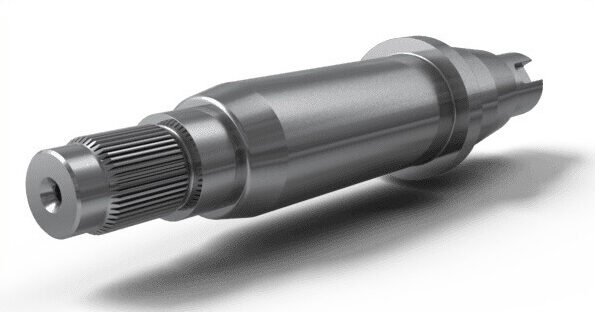Motor Shafts: An Ultimate Guide
Are you looking for reliable, long-lasting motor shafts to ensure your machines operate at peak performance? Then look no further! In this ultimate guide, we will provide you with all the information and advice needed to make an informed decision when selecting motor shafts.
By the end of this article, you will be armed with comprehensive knowledge about what makes a good motor shaft and how to find one perfect for your needs. So, if motors are an integral part of your business operations, read on and get ready to take your machining capabilities to a new level.
What are Motor Shafts?
A motor’s shaft is an integral component of the motor and the connection to convert electromechanical energy between the device and the motor. They are made up of cylindrical parts which transfer energy from the stator of the motor to the rotating output of the motor to support the rotating portion transfer torque and determine the location of the rotating portion concerning the stator.
What exactly is an engine shaft?
The motor shaft functions as the shaft that drives the rotor and facilitates its rotation when power is delivered to the windings of the stator. It serves as structural support for components of the rotor, like pulleys or bearings, and transfers torque generated by the output.
Depending on the purpose of use and the design of the motor shaft, they can feature tapered or straight threads on one end for connections. Furthermore, engineers could choose openwork designs to decrease weight but not sacrifice rigidity or strength.
What Are The Different Types Of Shafts?
There are two kinds of shafts employed in mechanical engineering.
Transmission Shafts
Countershaft
Countershafts can also be referred to as a jackshaft. They are the shafts utilized as an intermediary transmission component. They typically have a shorter form with support bearings on the opposite side.
Drive Shaft
A drive shaft transfers the power generated by an engine onto the wheels or any other moving components of a vehicle, such as. The shaft is equipped with a gear that rotates at both ends and connects to the rear and front wheelbase. The purpose of the drive shaft is to transmit electricity from your engine via a transmission and onto the wheels that allow it to travel.
Lineshaft
Lineshafts were a component that was widely used before the advent of tiny electrical motors that could be mounted locally on a machine or the system. They were employed to distribute power across the area of a factory or in which machines required power.
A variety of belts, gears, and pulleys were utilized to disperse the power of the main system, which could include a turbine, steam power, windmill, or even a water wheel. Go now and buy durable motor shafts for your next project.
Machine Shafts
Crankshaft
A crankshaft can be described as a mechanical component used to exchange reciprocating and rotational movement. They are powered by a crank mechanism comprising various crankpins and cranks. The crankpins are then linked to connecting rods in an engine.
What Are Shafts Made From?
Generally speaking, shafts are constructed of mild steel. When a strong shaft is required for a job that requires a more significant load, alloy steel is the choice, for example, nickel, nickel-chromium, or chromium-vanadium.
The material used in the structure is determined by the task for which it is intended to be used. Stronger metals are preferred for applications where shafts transfer lots of torque and also have the potential of experiencing some impact. Plastic is another type of material that can be used to make shafts. They are usually employed in light-load applications that only require a little torque.
Where Are Motor Shafts Used?
Shafts are utilized in many different mechanical systems, both in industrial processes and appliances you can find at home. Some of the most frequent locations where shafts are utilized include:
- Engines
- Applications for railways
- Automotive industry
- Inside gearboxes
- Crane industry
- Linking gearboxes
- Conveyor systems
- Paper industry
- Watches and Clocks
Motor Shaft Maintenance Tips
Motor shafts are an essential element of every motor. However, many need to learn how to take care of it properly. A proper maintenance routine will keep your motors in good shape and prolong their lifespan.
It’s crucial to realize the importance of regular cleaning in maintaining the motor shaft. Dust and dirt accumulate over time and cause motors to fail or to become inefficient. You can use an easy brush and non-abrasive cleaner to clean the motor. Avoid using harsh chemicals because they can harm the shaft’s surface. Also, it is recommended to lubricate the exposed parts with grease or oil once per month to avoid corrosion and rust from beginning to form.
To keep your motor operating smoothly, It’s also crucial to maintain the cleanliness of your motor’s housing. This is a must for gears, pulleys, or belts that connect with your motor shaft.
Shafts in a system: What Are Their Advantages And Disadvantages?
There are numerous advantages and disadvantages to mechanical shafts used in systems. We’ll take an in-depth look below:
Advantages
- If they are using a shaft, they are likely to avoid getting jammed quite often.
- They require less maintenance they are compared to chains.
- The weight of a shaft could be decreased by using a hollow shaft, an alternative to an actual shaft.
- Shafts are typically sturdy and minimize the risk of a system failing because of broken parts.
- High-strength.
- It can absorb the initial shock of high inertia torque.
Disadvantages
- If a coupling is used with a shaft, a loss of power is experienced.
- Shafts may cause a significant degree of vibration in the system if they’re not aligned properly.
- Shafts can cause noise.
- When they fail or require replacement, it could be costly.
- It is more difficult to restart a machine when a shaft breaks in the machine or system.
- Changing the speed with shafts is challenging compared to switching the speed with the sprockets or gears.

















